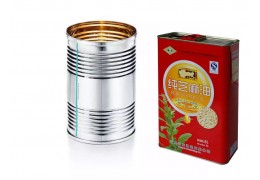Comment transmettre...
Tin can making process and tin can mold making
Thinning stretching of tin cans.
The punched cylindrical cup is sleeved on the punch, and the punch is extruded into a die along the axial direction. The gap between the die and the punch is smaller than the thickness of the cup wall, so that the wall thickness will be reduced when the diameter remains unchanged. get thinned. The metal volume of the cylinder after thinning is equal to the metal volume of the cup during the thinning and drawing process, which is also equal to the metal volume of the original slab. In the manufacture of cans, this process is repeated two or three times, with the punch with the cup passing through a series of dies, one stroke at a time. The most convenient way to install a stamped forest on a punch is to perform a re-stamping operation before the first thinning stretch.
Stamping of tin cans.
The manufacturing process of punching and cupping is generally as follows: unwinding ordinary strip coil; Xu lubricant; blanking and cup punching; re-stamping; thinning and drawing of cup side wall; bottom forming; . For dry beverage cans, outer surface coating, printing decoration, inner surface coating, open end flange forming and closing are also performed. For food cans, outer surface coating, open end flange forming, barrel corrugation and inner surface coating during cleaning or can ends are fabricated from pre-coated sheet on a multi-die press, can lid pressing There are corrugations (reinforcing ribs) to bear the internal and external pressure. The final step here is crimping to form a double hemmed seam to place filler on the final seal to act as a sealing gasket.
Tin can double crimp seal
1- The end cap is rolled and folded over the flange of the barrel
2-Sealing packing
3-sealing overlap
4-Cylinder
5-end cap
Manufacture of deep-drawn tin cans.
The steps of making deep-drawn cans are as follows: thin sheet strip coils are cut into swirl-shaped sheets; coating and finishing sheets (coils can also be coated); blank blanking and cupping; or secondary, depending on the size of the tank); forming the tank bottom; trimming the flange to the correct width; inspection and sterilization.
As with the punching process, a multi-die cup puncher is used to unload and unload a wide sheet coil or sheet and punch it into a shallow cup. Shallow cups are gradually reduced in diameter and increased in height by one and two re-stamping. When the final stamping is stopped to a certain extent, a flange is left on the can, like all other sheet metal forming processes. Irregular edges are cut off and the bottom of the tank is machined to the required shape.
Tin can processing equipment
The main equipment for can processing includes various stamping and forming machines, shearing and blanking machines and other auxiliary equipment. There are so many varieties of these devices that it's impossible—one introduction. In view of the characteristics of automatic production in modern canning industry, this chapter only briefly describes the composition of the punching and cupping production line.
Composition of stamping can production line
1- Unwinding machine
2- Roll selection inspection and lubricant application equipment
3- Single side thinning and stretching machine of the punching machine (simplified production)
4-Cut into machine
5-Tank Washer
6-External surface coating equipment
7-box furnace
8- Fill the device
9-box furnace
10-Hang back-flange forming machine
11- Inspection machine
12-Inner sprayer
13- Curing Oven
14- Local secondary spraying
15- Curing Oven
The sheet rolls are sent to the unwinding machine (unwinding stand) by the transport vehicle. The unwinder generally has two arms, one arm towards the sheet roll transport car, the other arm feeds the press, and the sheet roll can be changed by rotating the arm. The coils of sheet pass through lubricant coating equipment, lubricated on both sides, and pass through a pair of rubber rollers to remove excess lubricant. On older lines, the lubricant is formulated to the correct concentration and placed in a container, and refill into the lubricant tank as needed. On newer lines, an external circulation system is generally used, which allows temperature control, continuous filtration and constant lubricating oil quality.
The cup punching press is a specially designed double-action press. It punches several round slabs first, and then punches the round slabs into shallow cups. These two actions are done in one stroke.
The function of the cup wall thinning deep drawing machine is to transform the cup into a cylinder with the correct thickness distribution of the side wall and the bottom of the cup into a shape designed to resist internal pressure in use. Here, the cup is re-stamped and left on the punch, then passes through three thinning pull rings in sequence to thin the cup wall. Enter the auxiliary press at the end of the stroke to form the dome and cup base. At the beginning of the return journey, with the help of compressed air from the punch tube, the spring ejector rod unloads the can body from the punch, and the can is sent out of the machine by the conveyor belt.
Each cup wall thinning and deep drawing machine works in conjunction with a trimming machine. There are two types of edge trimmers: rail type and roller type. The rotating frame of the rail type trimmer is equipped with many cores, and the can edge is cut between the rotating core and the stationary rail. On the roller trimming machine, one end of the can is fed between the two rollers and rotates around its own axis, and the two rollers move closer to each other to complete the trimming action.
.jpg)


.jpg)
.jpg)









Derniers commentaires